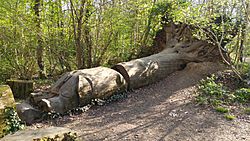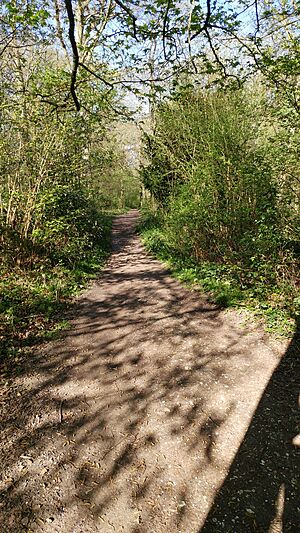Clayfield Copse facts for kids
Quick facts for kids Clayfield Copse |
|
|---|---|

Pig Sculpture from fallen tree in Clayfield Copse on April 2017
|
|
| Lua error in Module:Location_map at line 420: attempt to index field 'wikibase' (a nil value). | |
| Type | Local nature reserve |
| Location | Caversham, Reading, UK |
| Area | 8.65 hectares (21.4 acres) |
| Created | 1991 |
Clayfield Copse is a special natural area in Reading, UK. It's located on the northern edge of Caversham. This place is a "local nature reserve." This means it's protected to help nature thrive.
The copse is about 8.65 hectares in size. That's like 12 football fields! It has open fields, beautiful wild flower meadows, and native woodlands. These woodlands are next to the countryside of Oxfordshire. Some parts of the woodland are carefully managed. For example, hazel trees are cut in a traditional way called "coppicing." This helps new shoots grow. Old fences made from dead branches also mark some of the very old woodland areas.
Clayfield Copse is unique because it's the only place north of the River Thames in Reading where you can find "London Clay" soil. It's also the southern tip of the Chiltern Hills. The Reading Borough Council looks after this amazing nature reserve. You can also find a fun sculpture trail here!
Contents
History of Clayfield Copse
Clayfield Copse was once part of a large country estate called Caversham Park. In 1991, this area became Reading's very first local nature reserve. This was an important step to protect its natural beauty and wildlife.
Animals You Might See
Clayfield Copse is home to many different animals. Keep your eyes and ears open!
Birds
- Green woodpecker: This bird has bright green feathers and a red cap. You might hear its loud, laughing call.
- Eurasian golden oriole: This beautiful bird is known for its bright yellow feathers (on males). It has a lovely, flutelike song.
Plants and Fungi You Might Find
The reserve is full of interesting plants and fungi.
Trees
- Yew tree
- Cedar tree
- Wild Apple tree
- Wild Cherry tree
- Wild Pear tree
- Blackthorn
- Rowan tree
- Wild Service tree
- Hazel
- Silver Birch
- Hornbeam
Other Plants
- Wood Anemone: A delicate white flower that blooms in spring.
- Goldilocks Buttercup
- Lesser Celandine: A bright yellow flower, one of the first to appear in spring.
- Early Dog-violet
- Common Dog-violet
- Garlic Mustard
- Cuckoo Flower: A pale purple flower often seen in damp meadows.
- Honesty
- Cowslip: A yellow flower that looks like a bunch of keys.
- Primrose: A pale yellow flower, often found in woodlands.
- Redcurrant
- Wood Spurge
- Dog's Mercury
- Herb-Robert: A small plant with pink flowers and reddish stems.
- Wood Sanicle
- White Comfrey
- Hedge Woundwort
- Ground-ivy
- Ivy-leaved Speedwell
- Wood Speedwell
- Common Figwort
- Honeysuckle
- Bluebell: Famous for creating beautiful blue carpets in spring woodlands.
- Butcher's-broom
- Dogwood
- Spurge-laurel
- Mountain Melick
- Pendulous Sedge
- Wood Sedge
Fungi
- King Alfred's Cakes: A hard, black fungus that looks like burnt charcoal.


